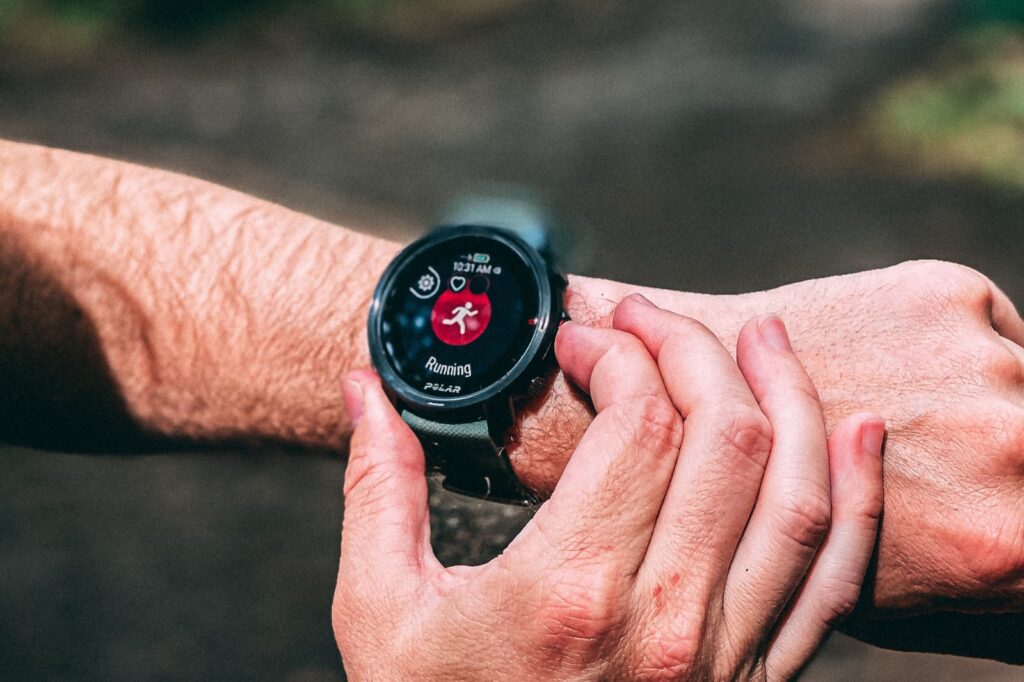
An analysis of the MAF method of heart rate training, Part 2 of 5 in our series
Runners of all ages and abilities
Floris Gierman, host of The Extramilest Podcast, co-founder of Path Projects, and long-time MAF enthusiast
This is part two of a five-part series on heart rate training, written by Floris Gierman, co-founder of run apparel brand PATH Projects, host of the Extramilest podcast, and running coach. Over the last 11 years, he’s devoted his life to heart rate training and building a community of running through the MAF approach to running. Through the course of his training, he’s lowered his marathon time from over 4 hours to 2:44 and attributes his success to his focus on heart rate training and a holistic approach to his training, racing and life.
Other posts in this series:
Many times, heart rate training is synonymous with MAF training, but there are several components that separate the two. MAF stands for Maximum Aerobic Function: our ability to burn body fat for nearly unlimited energy. A key focus of MAF training is to maximize natural fat-burning, which directly improves your health and fitness.
Improving your fat burning abilities can be done in a variety of ways, such as training at the right intensity, monitoring nutrition intake in a healthy and sustainable way, and managing stress levels.
While most training methods focus on variation of workouts in concert with nutrition and proper fueling, the MAF method starts at the foundation of fitness, focusing on the importance of developing your aerobic base fitness first. This is accomplished through low heart rate training, and only moves onto higher intensity running once a baseline aerobic fitness is established. In doing so, athletes are able to get faster without the common wear, tear and injury that plagues most runners.
Over time, the goal is to run faster at the same (or lower) heart rate, both in training and racing.

There are many benefits to lowering your training intensity (otherwise, why would we do it?). Here are the core benefits:
By training at a low heart rate, your body becomes more efficient at using oxygen to produce energy, leading to improved endurance over time. Training at a low heart rate increases the number of your mitochondria (part of a cell that makes energy) and improves their efficiency. The more mitochondria you have, the more energy you can create from fat burning. This means you can run faster at the same (or lower) heart rate.
Low heart rate training teaches your body to burn more fat for fuel, which can improve overall health, resulting in weight loss and improved race times. Since you have a nearly unlimited supply of fat, aerobically fit athletes who pace themselves well can still have energy left at the end of their race, at a time when many runners are forced to slow down significantly.
You are able to train consistently at higher training volume, with limited training stress on your body. Training at a lower intensity reduces the stress on the body’s joints, muscles, and tendons, reducing the risk of injury.
When you finish a low heart rate run, you should feel like you could do that run again. Low heart rate training can help the body recover more quickly after intense workouts, leading to improved performance over time.
Training at a low heart rate can be a meditative and relaxing experience, leading to improved mood, mental clarity, and reduced stress.

One misconception with MAF training is that it’s low intensity training only. There is absolutely a time and place with higher intensity training as well, but only after an aerobic base has been developed. Dr. Phil Maffetone, one of the foremost voices on heart rate training, also talks about this on his website FAQ:
“Train MAF until you plateau, or until you have been improving for 3-6 months. Then you add some speedwork. Most people respond well when their volume of anaerobic training is 15-20% of their total training while 80% is at or under MAF.”
The 80/20 rule applies to a variety of practices across a range of subjects, and the same is true for MAF training. For those unfamiliar with the rule, in the case of MAF training, 80% of runs will be done at an easy, aerobic pace, while 20% are done at a harder effort. This practice is used by plenty of elite athletes, from Tommy Rivs to Kilian Jornet to Eliud Kipchoge (a majority of his training is done 3-4 minutes slower than his race pace!). However, in the case of MAF training, the 80/20 rule begins only when the base-building phase is complete.
I prefer the MAF training approach of base building first for 3 months, before adding in speedwork, instead of right away jumping into 80/20. I see too many injured, unhealthy, overtrained athletes. Yes, even 20% high intensity running can bring too much training load too soon for athletes, especially if the stress levels in your daily life outside of running are already high. I have personally experienced this and seen this in many athletes through my coaching practice.
Does that mean you can’t do any high intensity or group runs during your base building? From a running coaching perspective, I look through the lens of bringing joy and consistency to athletes training. By all means, during your base-building phase, if you want to do one higher intensity run a week to blow off steam or catch up with your running group, go for it. For some runners, this helps to be disciplined enough to run the rest of their weekly runs at low enough intensity. However, I can’t stress enough that it’s important to not overdo the high intensity in this phase. Base building can be surprisingly slow for most runners, and it’s often too tempting to pepper in high intensity runs. Doing so will nullify the entire process and will return mediocre results, if any at all.
During base building, you develop your slow-twitch aerobic muscle fibers and you strengthen your joints, bones, ligaments, tendons and anaerobic fibers. This base building strengthens your body so it can handle more training load in the forms of training volume and intensity.
Dr. Phil Maffetone’s philosophy is a holistic approach to training, racing, and even life. Everything is connected. Your running intensities, nutrition, stress levels, sleep quality and recovery all play a massive role in your athletic performance. Many athletes, including myself 10 years ago, only focus on the running component and forget about the rest.
There are a few different ways to find out your optimal training intensity for aerobic exercise. Some common used options are:
Simply put, this is the most accurate way to determine your Zone 2 range for aerobic training. The goal with a blood lactate test is to find the highest heart rate that you can sustain while keeping your lactate level below 2.0 millimole per liter. A medical lab test can cost $150 to $250+ or you can use your own (expensive) device with test strips. This is not needed to start out with low heart rate training, but if you want the most accurate measurement and don’t mind paying for it, then go with this.
Keep in mind that this is just one data point. If you have an off-day on your LT test, you could set your training zones incorrectly as well. I’ve had to re-do an LT test in the past for inaccurate results, due to poor sleep/high stress the day before.
A fairly accurate and easy way to find your aerobic range (Zone 2) is to use a heart rate training zone calculator, like this one courtesy of Mottiv and Triathlon Taren. He also includes a simple workout to find your max heart rate.
Do a 15-20 minute warm up, and then keep running at a conversational pace. You should be able to have a comfortable conversation, yet the other person should notice you’re exercising since you sound a bit breathy. Look at what your heart rate is while you’re running. That said, this is probably the least accurate way to get your Zone 2 number since it’s highly subjective.

This formula gives a ballpark number for your Zone 2 heart rate and takes your age, health, and fitness profiles into account. That said, the MAF 180 formula is not accurate for everyone. For me, my blood lactate test was exactly the same number as the MAF 180 formula; however, for other athletes there can be a significant difference. For example, if you have an exceptional high max heart rate for your age, or if you’re an athlete over the age of 55, then further personalization may be needed by increasing your MAF training zone. Nevertheless, this simple formula will work reasonably well for most athletes.
Here is the calculation:
With this formula your aerobic training zone is between your max aerobic function and 10 beats below it, so 125 to 135 bpm. Training above this heart rate quickly shifts your body to burn more carbs and less fat for fuel.
A more detailed explanation with FAQ in the comments can be found at Dr. Phil Maffetone’s website here.
The main reason I prefer the MAF 180 formula is that this formula takes an athlete’s health profile and fitness background into account. This means if you’re just starting out training with poor fitness, or are coming back from an injury, illness, overtraining or burnout, you should train at a lower intensity than when you’ve been healthy, injury free and consistently improving in training and racing.
The amount of athletes that get injured or overtrained are higher than ever. I’m a strong believer in optimizing health first and your running performance will follow. This is something that Dr. Stephen Seiler and I also talked about on The Extramilest Show #50.
I suggest starting out with the MAF 180 formula. If you want, you can also do the Talk Test and Heart Rate Training Calculator as well. This will give you three data points and allow you to see how these overlap or differentiate at the start of your training.
Oftentimes, runners who are new to MAF training will want to find a formula with the highest aerobic HR to train at, because their aerobic pace is painfully slow, sometimes 2-3 minutes slower than the pace they’re used to running. Whenever in doubt, I suggest starting out with the lower HR number first. Slowing down, or even taking walk breaks, is part of the process. It may even seem humiliating at first, especially if you’re used to Strava street cred, but it’s important to stick to the plan.

In 2013, at the age of 30, I had to slow down significantly on my runs to keep my HR at or below my MAF heart rate of 150 beats per minute, averaging a pace of about 8:30 min/mile on flat.
In October 2022 at age 40, at the Chicago marathon, I finished in 2 hours 52 minutes (6:30 min/ mile) with an average heart rate of 149.
As we age, our heart rates naturally come down. Many MAF athletes will also notice that over time our bodies adapt and become more efficient. Getting to mile 20 (32 km) into a race and being able to run strong, passing many athletes and holding pace (or even picking up your pace a bit) is something not many endurance athletes ever experience. This is the best feeling in the world.
Find your MAF heart rate. By using a combination of the methods above, you can narrow down your ideal zone 2 heart rate. It may seem painfully slow to run at a pace that holds your heart rate in zone 2, but it’s important to stick to the plan. Everyone who starts MAF goes through it.
Which brings us to our next point: discipline. There’s a time and place for high intensity training and the 80/20 rule, but not before your base-building period is complete. Generally, base building will take 3 months, though for others it may take longer. It seems long at first, especially since you’ll have to slow down significantly. However, three months in the grand scheme of your running life is a small sacrifice for a huge reward further down the road.
The benefits of heart rate training are numerous, and will affect every area of your life. I’ve seen it in my own running, and I’ve seen it in the lives of hundreds of other athletes through my coaching practice. When you’re less stressed and injury free and have more mental clarity, you’re able to truly enjoy running, which will spill over into all other areas of your life.
When all of these things come together, you’ll find that running returns more than you could’ve ever imagined.
Additional Information
The Extramilest is Floris Gierman’s holistic training program, focused on marathon running and reaching your full potential in training, racing, and life. Learn more about it at the link below.
Have something to say? Leave a Comment

As the founder of The Extramilest Show and running coach of the PB Program, Floris helps runners become stronger, healthier and happier athletes. Unsurprisingly, he loves low heart rate training. Floris likes to go on adventure runs, though with a terrible sense of direction, he often gets lost. He is also the co-founder of PATH projects. When not running, Floris enjoys laughing with his two daughters, playing pickleball with his wife and sitting in an ice bath.
More from Floris

Great article. I too have been fascinated with zone 2 training. I am now 56 and started MAF about 15 months ago. While I have always been a runner, the last few years have been a struggle for me. I just figured it was my age. Then I discovered zone 2 and started the 80/20 training thing in April of 2022. While it seems so easy there were two difficult things – learning how to run slow and actually finding the correct zone 2 range (looking back mine was too low).
I can say without a doubt my endurance was MUCH better after 6 weeks or so, I felt good and had no issues other than I lost NO weight (belly fat). So after a few months I got a little discouraged and incorporated more HITT and then started to weight train 2X per week. I have gained about ten pounds and currently at a weight I have never been, even though I consistently work out (run and lift) 5 days a week.
After reading your article, I am going to re-discipline myself for the next three months with the zone 2 training (but continue to lift 2x/ week). Is there a zone 2 run program you have that you can share? Also, how would you recommend (If, at all) biking? Thank you and I look forward to the next 3 articles.
Hey Jamie, for a lot of answers to these questions we’d recommend checking out The Extramilest program by Floris (or listen to the podcast), listed at the bottom of the article. Thanks for reading, good luck on your journey!
I started this program on a challenging trail and barely ran at all, but power hiked 90%. I am coming off of an injury so haven’t run in more than 8 months. I would assume that this level of hiking rather than walking is normal and the tide will turn?